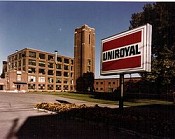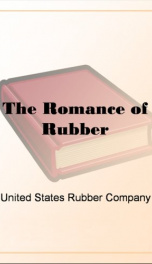United States Rubber Company

The United States Rubber Company was founded in Naugatuck, Connecticut in 1892. It was one of the original 12 stocks in the Dow Jones Industrial Average,[1] and became Uniroyal Inc. in 1961. In 1990, Uniroyal was acquired by France-based tire maker Michelin (Euronext: ML). One of Uniroyal's best known products is the Tiger Paw tire introduced in the 1960s and included as original equipment for that decade's musclecars such as the Pontiac GTO, which itself was promoted as The Tiger during its early years. Today, Uniroyal still uses the Tiger Paw brand name in its tire line. Uniroyal Inc. is not to be confused with Uniroyal, a Belgian tire manufacturer, now subsidiary of Continental AG. The Litchfield Rubber Co. moved to Naugatuck, Connecticut in 1847, and the name was changed to Goodyear's India Rubber Glove Mfg. Co., as it began to manufacture rubber gloves for telegraph linemen. It was the only company in which Charles Goodyear, inventor of the rubber vulcanization process, is known to have owned stock. By 1892, there were many rubber manufacturing companies in Naugatuck, as well as elsewhere in Connecticut. Nine companies consolidated their operations in Naugatuck to become the United States Rubber Company. From 1892 to 1913, the rubber footwear divisions of U.S. Rubber were manufacturing their products under 30 different brand names, including the Wales-Goodyear Shoe Co. The company consolidated these brands under one name, Keds, in 1916, and were first mass-marketed as canvas-top "sneakers" in 1917. These were the first sneakers. On May 26, 1896 Charles Dow created the Dow Industrial average of twelve industrial manufacturing stocks, which included among them U.S. Rubber Company.[2] In 1916, the Dow-Jones Industrial average expanded to a list of 20 stocks, and continued to include U.S. Rubber Company.[2] In 1928, the Dow-Jones Industrial average expanded to 30 stocks for the first time, but by then U.S. Rubber Company was no longer listed among them.[2] In 1915, Arthur H. Adams, then president of the United States Rubber Company, died in the sinking of the RMS Lusitania at the age of 46. He was hit by one of the falling masts. In 1931, U.S. Rubber Company bought a substantial interest in the Gillette Safety Tire Company, founded by Raymond B. Gillette. The rubber tire manufacturing plant was located in Eau Claire, Wisconsin. The purchase by U.S. Rubber was part of an effort to increase its share of the automobile tire market.[3] After 1931, the Gillette plant, with its contracts with the General Motors Corporation, became one of the world's largest supplier of original equipment tires. It produced Gillete brand tires, along with Ward, Atlas, and U.S. Rubber's brand, U.S. Royal.[3] In 1942, after the United States government put a freeze on scarce rubber for civilian use, the company sold the Eau Claire plant to the government, which then converted it to make small caliber ammunition, renaming it the Eau Claire Ordnance plant.[3] On December 31, 1943, U.S. Rubber repurchased the plant from the government for over US$1 million, and converted it back to synthetic rubber tire production. The Eau Claire plant was greatly expanded in later years. The plant was one of the oldest tire plant in the United States and, at one time, the largest private employer in Eau Claire and the second largest in Chippewa Falls before it was closed in 1991.[3] [4] Uniroyal, Dominion Rubber. In 1961 the company was renamed Uniroyal Inc.[2] As Uniroyal, the company became defendant in a landmark gender discrimination case, Chrapliwy v. Uniroyal, under Title VII of the Civil Rights Act of 1964. The case went on for years, ending up in the United States Court of Appeals for the Seventh Circuit by 1982. In 1980 Uniroyal Australia, a subsidiary, was purchased by Bridgestone Australia, which took over the Australian plants operated by the Uniroyal Tyre Company. Bridgestone Australia has three major manufacturing plants in Australia. Bridgestone Australia was traded on the Australian stock exchange, as a majority-owned subsidiary of Japan's tire company, Bridgestone Corporation. On May 11, 2007 Bridgestone Australia Ltd. became a wholly owned subsidiary of Bridgestone Corporation of Japan. (TYO: 5108) In 1985, Uniroyal was taken private by its management and the New York investment firm of Clayton & Dubilier in order to prevent a hostile takeover by financier Carl C. Icahn. At the time, Uniroyal was the fifth-largest tire company in the country. Its Uniroyal Chemical subsidiary, a produce of agricultural chemicals, industrial chemical additives and specialized rubber and plastic products, was sold to Avery Inc. for $760 million in 1986 to help pay the nearly $1 billion in debt incurred in the leveraged buyout. [5] [6] The remaining tire operation was merged with that of B.F. Goodrich Company (NYSE: GR), a S&P 500-listed tire and rubber fabricator, to form a joint venture partnership and became the Uniroyal Goodrich Tire Company. B.F. Goodrich Company held a 50% stake in the new tire company.[7] Goodrich made high-performance replacement tires.[3] The new Uniroyal Goodrich Tire Company headquarters was set up at the former B. F. Goodrich corporate headquarters, within its 27-building downtown complex in Akron, Ohio which contained Goodrich's original factory. In the fall of 1987 B.F. Goodrich Company shut down several manufacturing operations at the site, and most of the complex remained vacant until February 1988, when B.F. Goodrich announced plans to sell the vacant part of the complex to the Covington Capital Corporation, a group of New York developers.[8] In 1987, its first full year of operation, the new Uniroyal Goodrich Tire Company generated almost US$2 billion in sales revenue, with profit of about US$35 million.[7] However, the merger soon proved to be difficult.[3] In June 1988 B.F. Goodrich sold its 50% stake for US$225 million. The buyers were a group of investors led by Clayton & Dubilier, Inc. a private New York investment firm.[7] [9] At the same time, B.F. Goodrich also received a warrant to purchase indirectly up to 7% of the equity in Uniroyal Goodrich Tire Company.[10] Also in June 1988 as part of the sale deal, the new privately-held tire company acquired publicly-held debt of $415 million.[11] The Uniroyal Goodrich Tire Company offered the debt securities in two parts through underwriters led by Drexel Burnham Lambert Inc. The two instruments were a US$250 million issue of 14 ⅛% notes due in 1998, and a US$165 million issue of 14 ½% subordinated debentures due in 2000.[12] For the year 1988, Uniroyal Goodrich Tire posted sales revenue of US$2.2 billion, while profit declined to about a third of the prior year, less than US$12 million, which included an extraordinary credit of nearly US$2 million from the purchase of Canadian annuity pension obligations, and also a charge of over US$16 million from the June 1988 recapitalization resulting from the selloff by B.F. Goodrich.[13] Also in 1988, Michelin Group, a subsidiary of the French tire company Michelin et Cie (Euronext: ML) proposed to acquire the Uniroyal Goodrich Tire Company, and began acquiring a stake.[3] In 1989 Uniroyal Goodrich Tire Company posted sales revenue that was up to almost US$2.3 billion, but profit was down by 90% to just over US$1 million, but included over US$9 million extraordinary credit that year for the ongoing Canadian annuity pension obligation purchase. 1989 year-end net income results were also hurt by increased interest expense of nearly US$31 million on the June 1988 debt recapitalization, and a US$29 million charge for deferred employee compensation related to the proposed purchase of the company by Michelin Group.[13] By May 1990, Michelin Group had completed its buyout of Uniroyal Goodrich Tire Company from Clayton & Dubilier of New York. The deal was valued at about US$1.5 billion.[14] B.F. Goodrich surrendered its 7% warrant to Michelin Group for US$32.5 million.[10] B.F. Goodrich then exited the tire business entirely, and changed its name to Goodrich Corporation, in line with its plan to build its chemicals and aerospace businesses through reinvestment and acquisitions.[9] Michelin Group continued to operate the Uniroyal Goodrich Tire Company as its tire manufacturing unit in the United States and Canada. In January 1991 Michelin Group cut all 1,350 jobs at the historical Eau Claire, Wisconsin plant, prior to its closure that year. Later in 1991 it also closed three Uniroyal Goodrich Tire plants in Canada. It closed its tire-cord manufacturing plant in Lindsay, Ontario with 74 workers on August 30, 1991 due to high cost. Two tire factories with 1,000 jobs in Kitchener, Ontario were also closed citing overcapacity.[15] In mid 1991, the Uniroyal tiger returned to national television after a 10-year hiatus, featured in a new 30-second spot created by Wyse Advertising of Cleveland, Ohio. The animated Uniroyal tiger had been a television advertising icon for the company up through the 1970s. The new commercial appeared on ESPN and CNN sports-related programming, and also was run by Uniroyal dealers in local markets.[16] By 1993 Michelin North America employed 28,000 people at 18 plants, in South Carolina, Alabama, Oklahoma, Indiana, Nova Scotia and Ontario. In mid 1993 Michelin North America cut 2,500 of those jobs, which represented about 9% of its work force in the United States and Canada, because of softening demand for tires.[17] Through at least 2008, the Uniroyal Goodrich Tire unit continued to operate with about 1,000 workers at its tire plant in Woodburn, Indiana and also with two plants in Alabama (Tuscaloosa and Opelika).[18] The collection Uniroyal, Inc Records 1917-1990, Eau Claire MSS CB, is housed in the Special Collections and Archives Department at the University of Wisconsin- Eau Claire. The bulk of the records consist of labor contract negotiation and grievance case files, minutes, memoranda, correspondence, reports, photographs, blueprints, and films. The collection documents collective bargaining and labor relations with Local 19 of the United Rubber Workers of America, tire production, reconversion of the plant from ordnance to synthetic rubber production, and modernization after World War II. Additional newsletters, notices, membership lists, by-laws, correspondence, and photographs from 1948 to 1990 document the fundraising, social, and charitable activities of the Royaleers Club, an organization for female salaried employees. Certain basic documentation of the Eau Claire plant's operation is missing; there are no annual reports, personnel files, advertising, or sales department records in the collection. The collection is 33.2 cubic feet, consisting of 80 archives boxes and 3 flat boxes, 7 reels of film (8mm), and photographs.
do you like this author?
What readers are saying
What do you think? Write your own comment on this book!
write a commentWhat readers are saying
What do you think? Write your own comment on this author!
write a commentBook list

The Romance of Rubber
Series:
Unknown
Year:
Unknown
Raiting:
1/5
This book was converted from its physical edition to the digital format by a community of volunteers. You may find it for free on the web. Purchase of the Kindle edition includes wireless delivery.
Show more
add to favoritesadd In favorites
Book list

The Romance of Rubber
Series:
Unknown
Year:
Unknown
Raiting:
1/5
This book was converted from its physical edition to the digital format by a community of volunteers. You may find it for free on the web. Purchase of the Kindle edition includes wireless delivery.
Show more
add to favoritesadd In favorites
What readers are saying
What do you think? Write your own comment on this author!
write a commentif you like United States Rubber Company try:
readers also enjoyed
What readers are saying
What do you think? Write your own comment on this author!
write a commentif you like United States Rubber Company try:
readers also enjoyed
Do you want to exchange books? It’s EASY!
Get registered and find other users who want to give their favourite books to good hands!

